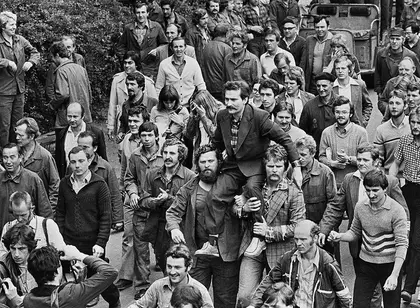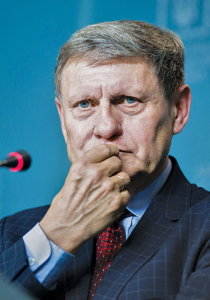It was a time of dramatic changes. In 1989, the Berlin Wall fell.
Two years later, the Soviet Union collapsed, giving birth to 15 newly independent states.
In this heady environment, Poland and Ukraine emerged: two large, neighboring, independent Eastern European countries poised to chart a new path after communism.
But nearly 30 years later, it is almost impossible not to notice how different their paths have been.
Poland is a member of the European Union and NATO, as well as among the fastest growing economies in Europe. As of 2017, its gross domestic product, or GDP, was around $524 billion. By contrast, Ukraine’s was a relatively puny $112 billion despite having an estimated four million more people than Poland — 42 million compared to 38 million.
Poland has wages roughly four times higher than Ukraine, which attracts hundreds of thousands of Ukrainian labor migrants. Meanwhile, Ukraine flounders. It has become the poorest country in Europe and is struggling for its territorial integrity defending its borders from Russia.
Even a casual visitor to both countries can easily wonder: where did Poland go right and Ukraine go wrong?
Brave new world
The economic difference wasn’t always so stark. In 1991, Poland’s GDP stood at $85.5 billion, according to World Bank data. By contrast, Ukraine’s GDP was $77.5 billion.
Ukraine also enjoyed one potential advantage over its Western neighbor: heavy industry. In the Soviet Union, Ukraine was a leader in machine-building, arms production, chemicals, iron, automotive and aerospace manufacturing, and high-tech research. Throughout much of the late Soviet period, it outpaced Poland economically.

What Might a Russo-Ukrainian War Peace Deal Look Like? Part 2.
But after the collapse of the Soviet Union in 1991, independent Ukraine’s GDP fell throughout the 1990s, only picking up again after the year 2000. Poland’s GDP, on the other hand rose more steadily until the global financial crisis of 2008. Even then, it was the only country in the EU to avoid a recession.
Early decisions
Why did these two countries’ paths diverge? The most obvious source of Poland’s success was a clear political consensus for decisive economic reform, experts say.
In 1989, when Poland shed Soviet dominance and communism imposed after World War II, the country was already in an economic crisis that had been brewing since the 1970s. Its government also emerged from the opposition, the independent trade union movement known as Solidarity.
This new political class was committed to a free market economy, rule of law, a division of powers and checks and balances. And because Poland was relatively more open than the 15 republics of the Soviet Union, many economists and new officials had received education or spent time in the West.
One of them was Finance Minister Leszek Balcerowicz, who had received a master’s in business administration from St. John’s University in New York in 1974. He transformed Poland with economic shock therapy.
“At the beginning, there was huge public support because people, to a certain degree, accepted the reality that these kinds of reforms were inevitable,” says Adam Balcer, a Polish political scientist. “That was a kind of window of opportunity for the political elite.”
The so-called “Balcerowicz Plan” helped to bring down inflation, lay the groundwork for a market economy, and even produce growth in 1992. Additionally, it led to the creation of a middle class of self-made entrepreneurs. But it also brought long-term high unemployment and hit the poorest segments of society hard.
By contrast, in Ukraine, the first post-independence government was largely drawn from the Soviet ranks. And unlike Warsaw, Kyiv lacked officials with significant experience abroad, and its economic advisors understood market economics poorly.
Ukraine’s institutions were also weaker. Because Poland was not part of the Soviet Union, its ministries were more experienced in conducting policy, says Pavlo Kost, a Polish-Ukrainian independent political consultant. Moscow influenced that policy significantly, but it was still Polish-made. By contrast, Ukraine’s Soviet-era ministries were directly plugged into Moscow.
“Ukraine had to start building its institutions from zero in 1991,” Kost says. When the country received independence, these institutions were simply “not prepared to build effective ways of curbing corruption” and “conducting state policy effectively.”
Ukraine’s potential advantage — heavy industry — may also have turned out to be a disadvantage.
Business people who would become modern Ukraine’s oligarchs took control of large state companies, launching themselves to wealth and political power. And Ukraine’s Soviet-era industry was heavily integrated with Russia, making Moscow the major business partner for the country.
Poland, on the other hand, had fewer huge firms. It also did one thing differently: although many reformers and Western institutions wanted to privatize state companies as quickly as possible, the opposition pushed back. As a result, large-scale privatization was delayed.
“When it came in 1996, the institutions and civil society were strong enough to ensure transparency and there was a market (with) market prices, so people knew what these assets were supposed to be worth,” says Marcin Piatkowski, a Polish economist and the author of the book “Europe’s Growth Champion.”
By contrast, in Ukraine, Russia, and the Czech Republic privatization went forward at the very beginning of the post-communist transition before the countries were ready to do it transparently.
“They ended up making oligarchs, and Ukraine is struggling with that until today,” Piatkowski says. “And Poland has virtually zero (oligarchs).”
Different realities
But not everything can be attributed to good decisions in Warsaw and bad ones in Kyiv. Despite appearing roughly the same on paper in 1991, Poland and Ukraine came from different political and social contexts.
Unlike in Ukraine, agriculture was never truly collectivized in Poland and agricultural land largely remained in private hands. Compare that to Ukraine, where a moratorium on the sale of land remains in place today.
And while the Soviet Union suppressed religion in the name of state atheism, Poland’s position was milder — especially after the 1953 death of Stalin.
Due to the Nazi genocide of Polish Jews and Soviet-engineered population transfers, after 1945 Poland became a nearly monoethnic and entirely Catholic country. The Roman Catholic Church proved to be a central component of Polish identity and a unifying alternative to the communist authorities.
“When you look at the church from the point of view of a social institution, you can see it gives people the opportunity to connect, to communicate, to create something…that is not controlled by the state,” says Iryna Fedets, a senior research fellow at Kyiv’s Institute for Economic Research and Policy Consulting.
And Poland’s 2004 accession to the European Union was not just the result of government efforts. It also stemmed from a Europe that committed to returning Poland and many Eastern Bloc countries to the fold.
By contrast, Ukraine was a diverse society with cultural, linguistic, religious, and even economic divisions. It spent more years under communism than Poland, and suffered the brunt of collectivization early on.
And, until 2014, its elite never chose and maintained a clear path for the country: toward Russia, toward Europe, or toward neutrality. It lacked a clear political identity, and had a history of less engagement with the West than Poland.
For this reason, while Fedets doesn’t want to “play the victim,” she also stresses circumstance played a key role: Ukraine was fully integrated into the USSR, while Poland wasn’t.
“At least in Poland there was some more economic freedom on a very small level… it was less restricted than Ukraine,” she says.
Political scientist Balcer also agrees. Despite their similar GDPs in 1991, he believes that Poland and Ukraine cannot be entirely viewed as starting from the same point.
But this shouldn’t be used as an excuse for the failures of the country’s leadership.
After the EuroMaidan Revolution drove President Viktor Yanukovych from power in 2014, Ukraine “achieved much more in these four years than in the (last) 20 years,” Balcer says. “And that is evidence that they could have achieved much more in the past.”
You can also highlight the text and press Ctrl + Enter








